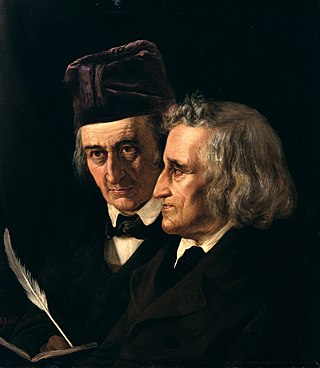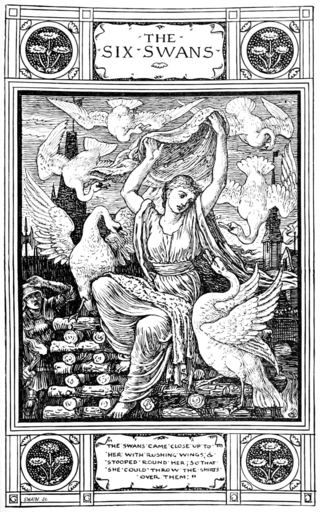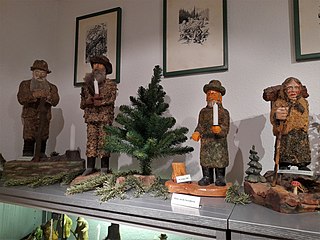
Jacob Ludwig Karl Grimm, also known as Ludwig Karl, was a German author, linguist, philologist, jurist, and folklorist. He formulated Grimm's law of linguistics, and was the co-author of the Deutsches Wörterbuch, the author of Deutsche Mythologie, and the editor of Grimms' Fairy Tales. He was the older brother of Wilhelm Grimm; together, they were the literary duo known as the Brothers Grimm.

The Brothers Grimm, Jacob (1785–1863) and Wilhelm (1786–1859), were German academics who together collected and published folklore. The brothers are among the best-known storytellers of folktales, popularizing stories such as "Cinderella", "The Frog Prince", "Hansel and Gretel", "Town Musicians of Bremen", "Little Red Riding Hood", "Rapunzel", "Rumpelstiltskin", "Sleeping Beauty", and "Snow White". Their first collection of folktales, Children's and Household Tales, began publication in 1812.

German folklore is the folk tradition which has developed in Germany over a number of centuries. Seeing as Germany was divided into numerous polities for most of its history, this term might both refer to the folklore of Germany proper and of all German-speaking countries, this wider definition including folklore of Austria and Liechtenstein as well as the German-speaking parts of Switzerland, Luxembourg, Belgium, and Italy.

"Frau Holle" is a German fairy tale collected by the Brothers Grimm in Children's and Household Tales in 1812. It is of Aarne-Thompson type 480.

Grimms' Fairy Tales, originally known as the Children's and Household Tales, is a German collection of fairy tales by the Grimm brothers or "Brothers Grimm", Jacob and Wilhelm, first published on 20 December 1812. Vol. 1 of the first edition contained 86 stories, which were followed by 70 more tales, numbered consecutively, in the 1st edition, Vol. 2, in 1815. By the seventh edition in 1857, the corpus of tales had expanded to 200 tales and 10 "Children's Legends". It is listed by UNESCO in its Memory of the World Registry.

"The Six Swans" is a German fairy tale collected by the Brothers Grimm in Grimm's Fairy Tales in 1812. It is of Aarne–Thompson type 451, commonly found throughout Europe. Other tales of this type include The Seven Ravens, The Twelve Wild Ducks, Udea and her Seven Brothers, The Wild Swans, and The Twelve Brothers. Andrew Lang included a variant of the tale in The Yellow Fairy Book.
"The Three Languages" is a German fairy tale collected by the Brothers Grimm, tale number 33. It is Aarne-Thompson type 671.
"Thumbling," published in German as "Daumesdick" is a German fairy tale collected by the Brothers Grimm in Grimm's Fairy Tales in 1819. The Grimms included another, similar story, "Thumbling's Travels." Both stories are related to the English Tom Thumb and often share its title when translated into English.

The moss people or moss folk, also referred to as the wood people or wood folk or forest folk, are a class of fairy folk, variously compared to dwarfs, elves, or spirits, described in German folklore as having an intimate connection to trees and the forest. In German, the words Schrat and Waldschrat are also used for a moss person. The diminutive Schrätlein also serves as synonym for a nightmare creature.
Jewish folklore are legends, music, oral history, proverbs, jokes, popular beliefs, fairy tales, stories, tall tales, and customs that are the traditions of Judaism. Folktales are characterized by the presence of unusual personages, by the sudden transformation of men into beasts and vice versa, or by other unnatural incidents. A number of aggadic stories bear folktale characteristics, especially those relating to Og, King of Bashan, which have the same exaggerations as have the lügenmärchen of modern German folktales.

Anderl (Andreas) Oxner von Rinn, also known as Andreas Oxner, is a folk saint of the Roman Catholic Church. A later writer alleged that the three-year-old boy had been ritually murdered by the Jews in the village of Rinn. The story is an example of a Blood libel common in medieval Europe.

The German Fairy Tale Route is a tourist attraction in Germany originally established in 1975. With a length of 600 kilometres (370 mi), the route runs from Hanau in central Germany to Bremen in the north. Tourist attractions along the route are focused around the brothers Wilhelm and Jacob Grimm, including locations where they lived and worked at various stages in their life, as well as regions which are linked to the fairy tales found in the Grimm collection, such as The Town Musicians of Bremen. The Verein Deutsche Märchenstraße society, headquartered in the city of Kassel, is responsible for the route, which travellers can recognize with the help of road signs depicting the heart-shaped body and head of a pretty, princess-like creature.

Johann Gustav Gottlieb Büsching was a German antiquary. His knowledge of subjects pertaining to Germany in the Middle Ages was notable.
Franz Xaver von Schönwerth was a Bavarian civil servant who was an important collector of folklore in the Upper Palatinate region.

The Bergmönch is a mountain spirit from German folklore. He is also known as Meister Hämmerling.
"The Soul Cages" is a fairy tale invented by Thomas Keightley, originally presented as a genuine Irish folktale in T. Crofton Croker's Fairy Legends and Traditions of the South of Ireland (1825–28). It features a male merrow (merman) inviting a local fisherman to his undersea home. The "soul cages" in the title refer to a collection of human souls that the merman kept in his home.

The Jew Among Thorns, also known as The Jew in the Brambles, is an antisemitic fairytale collected by the Brothers Grimm. It is a tale of Aarne–Thompson type 592. A similar antisemitic tale in the collection is The Good Bargain.

Donald J. Ward was an American folklorist who was Professor of German and Folklore and Director of Center for the Study of Comparative Folklore and Mythology at University of California, Los Angeles. He specialized in the study of Germanic and Indo-European mythology.
Yoshiko Noguchi is one of the leading researchers on Grimm's Fairy tales in Japan. She is a professor of German, comparative literature, cultural studies, children's literature, folklore, and gender studies. She is a professor emeritus at Mukogawa Women's University and a professor at division of children's literature, graduate school of Letters, Baika Women's University. She was born in Osaka and her maiden name is Hiiragi. She is different from other researchers in that she discusses how Grimm's fairy tales are accepted in Japan and the UK from an interdisciplinary perspective. She has recently unraveled a long-standing mystery in the history of German-Japanese cultural exchange. She successfully identified three Japanese that visited Jacob Grimm in Berlin in 1862.

Dorothea Grimm was the mother to the "Brothers Grimm" Jacob and Wilhelm, and seven other children, including Ludwig Emil Grimm and Charlotte Amalie Grimm.














